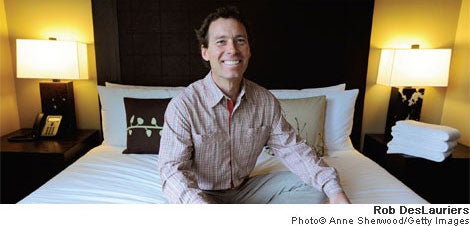
Former professional skier Rob DesLauriers used to throw himself off cliffs, both for fun and for the camera. Now a resort property developer in Jackson Hole, Wyoming, he's throwing himself into potentially scarier terrain: building and managing green luxury hotels. "The natural world has taken very good care of me, and now I want to do my part to take care of it," says DesLauriers. So, in 2006, he founded Terra Resort Group. The company's first LEED Silver-certified Hotel Terra Jackson Hole has made a few leaps of its own. Shortly after opening in February 2008, it was included in Cond� Nast Traveler's "Hot List," and occupancy rates have since been at least equal to that of other luxury hotels in the area. "Finding products and ways to do things that are the right combination of luxury and sustainability--and also in our budget--might take extra time," says Ashley Morgan, Terra's corporate director of sustainability. "But if you invest the time, the social, environmental and economic rewards are there."
"This is just the beginning though," DesLauriers adds. "The more we do with Hotel Terra--whether it's purchasing sustainable energy to offset the electricity we use or putting recycling containers in each room--the more we realize there is to do." Last month, the hotel opened 60 additional rooms, all as luxuriously green as its first 72. By 2015, Terra plans to have 12 to 15 properties in resort locations worldwide.
The mattress:Each of these mattresses--made from recycled steel springs, natural latex and organic cotton--keeps about 60 pounds of petroleum-based chemicals from spilling into the environment.
The TV:Energy Star-approved flat-screen HD TVs don't just look good: Outfitted with a high-tech IP system, they function like computers and help reduce guest paper use.
The linens:These Coyuchi linens are made from upland cotton, organically grown and handpicked in India. "I was thinking about these when I was stuck in a tent on the side of Mt. Vinson in Antarctica," says DesLauriers.
The carpet:Low VOC (volatile organic compound) carpets and pads improve indoor air quality-and reduce the health risks, such as liver and kidney damage, associated with VOCs.
The pillows:The pillowcases are made from discarded plastic bottles. Hotel Terra uses fewer plastic bottles by providing guests with aluminum canteens and installing pumps in bathrooms for toiletries like its organic shampoo.
The windows:Oversize low-e (low-emissivity) windows retain heat in the winter and reflect it in the summer, reducing the need for supplemental heating and cooling. They also offer views of the nearby Teton Range.
The walls:Fly ash, a byproduct of coal burning, replaced 25 percent of the cement needed to construct Terra Hotel's walls. Plus, 80 percent of the building's steel is recycled.
The bathroom:Dual-flush toilets and low-flow faucets reduce the hotel's annual water use by 34 percent-as do solar-powered faucets and xeriscaping (landscaping that reduces the need for irrigation).
The rest of this article is locked.
Join Entrepreneur+ today for access.
Already have an account? Sign In